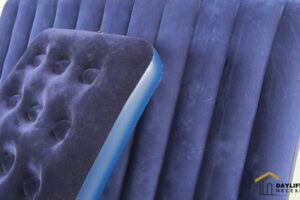If you’ve ever dealt with a flooded basement, you know the headache it can cause. One of the key components in keeping your basement dry is the sump pump discharge pipe.
In this guide, we’ll walk you through the process of insulating your sump pump discharge pipe, ensuring it remains effective and reliable in preventing basement flooding.
Say goodbye to damp nightmares and hello to a cozy, dry basement!
Why Insulation Matters
Think of your sump pump discharge pipe as the bridge between your basement and the great outdoors.
Without insulation, cold weather can cause the water in the pipe to freeze, blocking the flow and potentially damaging the pump.
Proper insulation keeps the water flowing freely, preventing clogs and ensuring your basement stays dry.
Understanding Your Sump Pump System
Before you start insulating, familiarize yourself with your sump pump system. You’ll need to locate the discharge pipe and understand its path to the outdoors.
This will help you determine the length of insulation you’ll need and identify any potential obstacles.
Choosing the Right Insulation Materials
Not all insulation materials are created equal. Opt for foam pipe insulation, which is both affordable and easy to work with.
It also provides excellent protection against freezing temperatures. Make sure to choose insulation with a suitable R-value for your climate.
Gathering the Necessary Tools
To tackle this project, gather the following tools:
- Measuring tape
- Utility knife
- Foam pipe insulation
- Duct tape
- Zip ties
These tools will make the insulation process smoother and more efficient.
Measuring and Preparing the Pipe
Measure the length of the discharge pipe to determine how much insulation you’ll need. Use a utility knife to cut the foam insulation to the required length. Remember to account for any curves or bends in the pipe.
Applying Insulation to the Discharge Pipe
Now comes the fun part. Gently split the foam insulation along its length and wrap it around the pipe. The split design makes installation a breeze. Make sure the insulation fits snugly without any gaps.
Securing the Insulation
Use duct tape or zip ties to secure the insulation in place. This step ensures that the insulation remains effective even during heavy water flow. Take your time to secure it properly along the entire length of the pipe.
Insulating Check Valve and Fittings
Don’t forget about the check valve and fittings in the discharge pipe system. Insulate these as well to prevent freezing. Cut small pieces of foam insulation and secure them around these components.
Wrapping Up: Final Steps
Step back and admire your work! Run a quick test of your sump pump to ensure it’s working as expected.
Check for any leaks or loose insulation. With the insulation in place, your sump pump system is now better equipped to handle whatever nature throws its way.
Maintenance Tips for Your Sump Pump
Maintaining your sump pump system is essential for its longevity. Regularly inspect the discharge pipe and insulation for any signs of wear or damage.
Clear away debris that might accumulate around the pipe opening to ensure proper water flow.
Benefits of a Well-Insulated Discharge Pipe
Beyond preventing freezing, a well-insulated discharge pipe also reduces the risk of condensation.
Condensation can lead to mold and mildew growth, which is not only bad for your basement but also for your health.
Insulation keeps the pipe temperature stable, minimizing the chances of condensation.
Common Mistakes to Avoid
Avoid these common mistakes when insulating your sump pump discharge pipe:
- Incomplete insulation: Ensure every inch of the pipe is properly insulated, including fittings and valves.
- Using the wrong insulation: Choose insulation with the appropriate R-value for your climate.
- Poorly secured insulation: Use strong tape or zip ties to keep the insulation in place, even during heavy water flow.
When to Seek Professional Help
If you’re unsure about any step of the insulation process or encounter unexpected issues, don’t hesitate to seek professional assistance.
A sump pump expert can ensure the job is done correctly and help you avoid costly mistakes.
Read More:
- How to Insulate Walls Without Removing Drywall
- The 10 Best Water Seal For Wood of 2023: A Comprehensive Review
- Top 6 Best Battery for Sump Pump Backup of 2023: Power Outages No More
- Top 7 Best Hot Water Heater for Large Family of 2023: A Comprehensive Guide
Conclusion
Congratulations! You’ve taken a proactive step toward a dry and comfortable basement by insulating your sump pump discharge pipe.
With proper insulation, you’re not just preventing freezing; you’re safeguarding your home from potential water damage.
So the next time rain pours, you can relax knowing your sump pump system is ready to tackle whatever challenges come its way.
Frequently Asked Questions
Q1: Is foam insulation the best choice for sump pump discharge pipes?
A: Yes, foam insulation is a great choice due to its affordability and effectiveness in preventing freezing.
Q2: Can I install the insulation on my sump pump discharge pipe myself?
A: Absolutely! The process is straightforward, but if you’re unsure, don’t hesitate to ask for professional help.
Q3: How often should I check my sump pump system’s insulation?
A: It’s a good idea to inspect it annually before the cold weather sets in.
Q4: Will insulating the discharge pipe also reduce noise from the sump pump?
A: While insulation can help dampen vibrations, it’s not the primary solution for noise reduction. Consider adding noise-absorbing materials if noise is a concern.
Q5: Can I use regular tape instead of duct tape to secure the insulation?
A: Duct tape is recommended due to its durability and water resistance. Regular tape may not hold up well over time.




